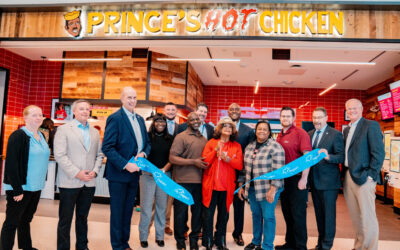
For the past decade or so, there has been a notable shift in the food and beverage offerings at most U.S. airports. One underlying theme has been to strive to provide a “sense of place” by bringing local concepts and operators to showcase the best of what an individual city has to offer.
Remarkable successes have ensued, with local-centric food and beverage offerings at airports such as Portland International (PDX) and San Francisco International (SFO) registering some of the highest passenger spends in the industry. But despite those successes and others, some experts in the industry are questioning whether the pendulum has swung too far in favor of local food and beverage brands at the expense of national chains.
Though perhaps not as exciting as local concepts, some argue that national chains deliver what the passenger wants yet are being routinely passed over by airports wanting “new” and “local” concepts.
“Change for the sake of change is not always the best thing,” suggests Stanley Synkowski, vice president of development for PremAIR Hospitality Group. “I know today there’s a push for change, to add local flavor. But what they’re doing in some cases is pushing out a lot of very successful brands that have performed well both at the airport and on the street. They have solid operating infrastructure and good products, and that’s what a lot of consumers are looking for.”
Others argue that local is a better choice.
“Honestly, when you do it right, local definitely performs better,” says Scott Kilgo, senior manager of concessions development at PDX.
The Case For National Brands
Most industry executives agree that airports should provide a balance of local and national brands to appeal to a broad array of consumers. In fact, nobody is arguing for a program with all national food and beverage brands, but some say the move to local brands may need a correction.
“The pendulum may have swung too far,” says Bruce Boudreau, director of Jacobs Consultancy. “There may have been an overreaction to the usual suspects of national brands at airports, although I do think people got tired of seeing the same national brands when they travel.”
Although noting that each airport has to achieve a balance that is appropriate for its community, Steve Johnson, senior vice president of business development for HMSHost Corp., says national brands should not be ignored.
“There is room for national brands, and they probably have a place in all programs,” he says. “We’ve seen local or regional brands replace national brands and not match the sales because the consumer doesn’t know them.
“What’s happening is by focusing on local restaurants, airports are sometimes bypassing what the consumer really wants,” Johnson adds. “Airports and concessionaires need to take the temperature of the passengers, find out not just what the airport wants but what the passengers want. If you have a 100% local program and 60% of your people are coming from somewhere else, the program means nothing to them and it feels generic.”
Synkoski agrees that airports would be well-advised to keep national brands in mind.
“I’m not saying every airport should look the same,” he says. “I’m saying there is room for local, regional and national brands. But what I see today is airports throwing out the baby with the bathwater with the attitude that they don’t want these brands because they’ve ‘been there, done that.'”
And national brands that might deserve consideration are being passed over, he argues.
“Breakfast icons like Denny’s or IHOP don’t get a chance because the airport wants the newest, latest breakfast concept,” he adds. “But those brands deliver what many people want.”
Although national brands don’t provide a sense of place, in some cases they can deliver on an airport’s desire for local involvement through franchises operated by locals.
“We love to have strong local owners operating strong regional or national franchises,” says Mark Knight, president of BAA USA Inc. “It’s the best of both worlds: solid local participation and the benefit of high-profile brands.
“What the national brands have going for them is the brand is recognized, which reduces that decision-making time for the consumer because they know what to expect,” Knight adds. “The local brands don’t have the same recognition.”
The Local Argument
One of the seven planning principles espoused by consulting firm SH&E is that airports seek to showcase regional characteristics in their programs to “ensure that passengers have a subconscious feel that they are in your city as opposed to any other,” says Stephen Freibrun, principal.
That’s been a commonly held belief in much of the airport industry for nearly the past decade, and in most cases it makes sense, he says.
Freibrun admits that “it doesn’t necessarily make sense that you follow this principle in every airport. If you can’t communicate the regional characteristics either through concepts, products, brands or architecture, then you need not pursue it.”
Paul McGinn, president of MarketPlace Development, agrees, noting that smaller hub cities are not going to have a large pool of local players from which to draw, and they may not have a food culture strong enough to make a statement.
“The airport really needs to consider that when they’re trying to establish a flavor of their community, that they make sure it’s the flavor that the national public wants to experience,” he says.
But if you can communicate positive regional characteristics, enthusiasm for local brands prevails. PDX was one of the first airports to skew heavily to local brands, and has been one of the most successful. Kilgo says the airport trains and nurtures its local partners to help increase their chance of success, and the efforts have paid off.
PDX focuses on bringing in local food and beverage concepts that have been highly successful off airport. For example, the airport replaced a Quizno’s with Flying Elephants Delicatessen, which has a 30-year history in Portland, Ore. The local brand’s sales are 150% to 160% of what Quiznos was doing.
Cheryl Nashir, associate deputy director of revenue development and management for SFO, thinks the airport’s food and beverage concessions offerings – 100% local in the international terminal and more than 90% local in the domestic terminal – are the right mix for the city.
“San Francisco is a sophisticated, progressive city,” she says. “We have great local food and for us it absolutely works.”
Industry executives also say that local brands that are truly local – those that exist and thrive off-airport – are more likely to succeed than those created to convey a local feel. Kilgo says that PDX’s local concepts resonate with travelers because they are successful brands in Portland.
“Those brands that are local-in-name only don’t survive because they couldn’t survive off-airport, so why would they survive on-airport?” he asks.
Read the rest of this story in ARN’s annual July Food & Beverage issue!
Click Here to subscribe to Airport Revenue News!





